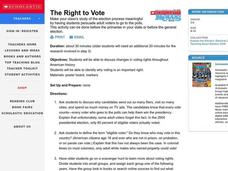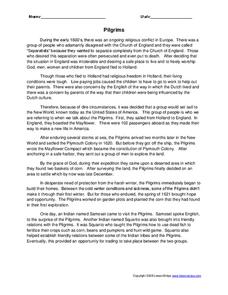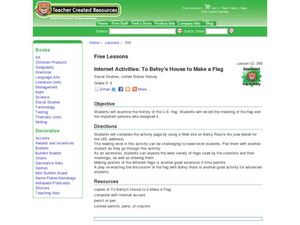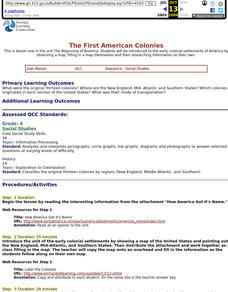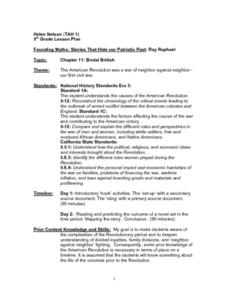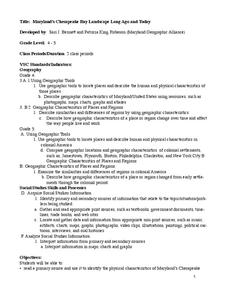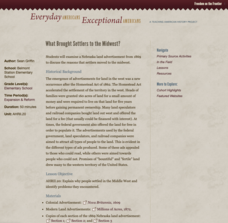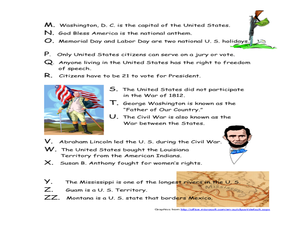Curated OER
The Right to Vote
In this voting worksheet, students identify and discuss changes in voting rights throughout American history.
Then, they identify why voting is an important right for Americans. Finally, students create voting bookmarks instead of or in...
Curated OER
Presidents' Day Activities
President's Day activities can provide a variety of ways to help students learn about the presidents.
Curated OER
Comparisons
In this making comparisons in history worksheet, students read 8 statements. Students put a C after statements that refer only to Columbus's voyage. Students put a P for those that refer only to the Pilgrims, a B for those that refer to...
Curated OER
Pilgrims
In this pilgrims worksheet, students read facts about the history of the Pilgrims beginning during the early 1600's and ending with the first Thanksgiving. Students answer thirteen short answer questions.
Curated OER
The War for Independence: 4th Grade
Here is a great interactive idea that may need a little refining. Students play 3 rounds, where they answer questions explaining how different countries have gained independence throughout history. While this resource has music and...
Curated OER
Learning About the Civil Rights Movement Through Photographs
Pupils examine the racial inequality that existed in the United States before the Civil Rights Movement. After listening to song lyrics and viewing photographs, they discover the importance of the movement in helping society move toward...
Curated OER
Internet Activities: To Betsy's House to Make a Flag
Students investigate the history of the American flag. In this U.S. history lesson, students read "To Betsy's House to a Make a Flag" and complete an Internet activity regarding the life of Betsy Ross.
Curated OER
Thomas Jefferson and the Declaration of Independence
Students examine readings and symbols to learn about the War of Independence and Thomas Jefferson. In this War of Independence instructional activity, students explore the role of Thomas Jefferson in the Declaration for Independence....
Curated OER
The First American Colonies
Fourth graders are introduced to the early colonial settlements of America by observing a map, filling in a map themselves and then researching information on their own.
Curated OER
North Carolina
In this North Carolina worksheet, students read about the early history of North Carolina and answer true and false questions about it. Students answer 10 true and false questions.
Curated OER
Family Life
Students investigate the lives of families in two different centuries. They compare the 1600's to the 1800's. Students write an essay about the differences and how they developed in history. Special attention is paid to the external...
Curated OER
American History Lesson Plans
It's always a good time for students to go over lesson plans that talk about America's birth.
Curated OER
Brutal British
Students read and predict the outcome of a story set during the Civil War, then map the story. To prepare for the activity, students determine why it is important to look at historical events from all angles by using primary and...
Curated OER
Learning from the Past: A New Approach
Young scholars research nonprofit organizations. As they research, they learn how those living in the colonial period formed community organizations to provide for the common good of their society. Each pupil chooses one organization to...
Curated OER
French and Indian War
Fourth graders engage in activities that familiarize them with the causes of the French and Indian War. They discuss the problem that started the war, the countries involved, and the effects to come about as a result of the French and...
Curated OER
Blessings of a Free Government: The Louisiana Purchase in 1803
Young scholars may take part in a multitude of activities listed such as creating political cartoons, comparison papers, and creating a portfolio to reinforce concepts and ideas surrounding the Louisiana Purchase.
Curated OER
Ben Franklin the Good Citizen
Students investigate Benjamin Franklin's contributions to society. For this history lesson, students read about Franklin's philanthropic behavior and play a bucket brigade game to re-enact how fires were put out during colonial times.
Curated OER
Maryland’s Chesapeake Bay Landscape Long Ago and Today
Combine a fantastic review of primary source analysis with a study of Captain John Smith's influence on the Chesapeake Bay region in the seventeenth century. Your young historians will use images, a primary source excerpt, and maps...
Curated OER
Aquarium Bill of Rights
Students review the Bill of Rights on Aquademics and list the rights that are guaranteed to United States citizens. In groups, they role play the role of important leaders whose rules would make a difference for the lives of fish in...
US Citizenship and Immigration Services
Thanksgiving 1—Pilgrims and American Indians
The Pilgrims first arrived in America in order to gain religious freedom. Here is a lesson that takes the class on this journey with the Pilgrims, stopping to look at how they got here, who they met when they arrived, and a peek into...
Roy Rosenzweig Center for History and New Media
What Brought Settlers to the Midwest?
Drawn by promises of fertile land, thousands of settlers poured West because of the Homestead Act of 1862. By examining images of the ads that drew them westward, learners consider the motivations for movement. They also consider how the...
Curated OER
The Affects of Environment on Native American Culture
Students research the culture of the Native Americans. For this U.S. History lesson, students are given the major geological areas where the Indians lived prior to the arrival of the Europeans, then they create a notebook that...
Curated OER
Independence Masks
Students explore how art reflects the economic, political, social, religious and historical concerns of a culture. They research a former colony to determine if there is any history of a mask. Students create a mask representing the...
Curated OER
False Statements
In this false statements of history worksheet, students identify false statements out of a group of statements. Students identify 9 false statements.
